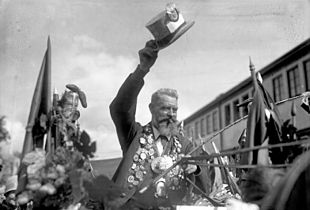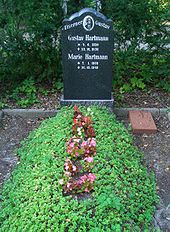Gustav Hartmann (cab driver)

Gustav Andreas Theodor Hartmann (born June 4, 1859 in Magdeburg , † December 23, 1938 in Berlin ) was a cab driver from Berlin-Wannsee and was known as the Iron Gustav .
Life


Gustav Hartmann, son of a coachman, first completed an apprenticeship as a baker before moving to the capital of Berlin. There he first opened a grocery store , with which he had little success. At the age of 26, on April 1, 1885, he founded his own haulage company in Berlin-Wannsee, the "Wannseedroschken".
Gustav Hartmann started on April 2, 1928 with his cab and the gelding Grasmus , accompanied by the newspaper reporter Hans Hermann Theobald , on a trip to Paris , where he arrived on June 4, 1928. This trip was supposed to be an action against the decline of the cab trade and the increasing number of cars. The journey was over 1000 kilometers.
“He always stood at the Wannsee train station with his carriage. And then he was already called Iron Gustav because he waited eagerly for the last train. Then one day a French woman, Madame Rachel Dorange, came and spoke to him. “Yes, where does Madame come from?” - “From Paris on horseback.” - “Oh, what a woman can do, I can do it too! I will visit you next year. ""
"The oldest driver from Wannsee, founder of the Wannsee hackney, allows himself to make the last trip Berlin - Paris with the 120th hackney, since the horse material is on the extinction budget."
Aftermath
Made famous by his travels, after his return the “Iron Gustav” set up a foundation for the survivors of taxi drivers who died while practicing their profession (Gustav Hartmann Foundation). His story was told by Hans Fallada in the novel Der Eiserne Gustav , published in 1938, Fallada naming the protagonist of his book Gustav Hackendahl . The novel was translated into many languages and filmed in a feature film of the same name with Heinz Rühmann and in a seven-part television series with Gustav Knuth .
Gustav Hartmann was buried in the old Wannsee cemetery. His grave, as an honorary grave of the city of Berlin , is in Dept. 9-7.
Contrary to the legend, which is based on Fallada’s account, Hartmann did not categorically reject motor vehicles in the cab industry. In fact, at the time of his trip he owned a taxi himself.
In Berlin, at the intersection of Potsdamer Strasse and Landwehr Canal, on the median of Bundesstrasse 1, there has been a memorial to the "Iron Gustav" ( Lage ), designed by Gerhard Rommel, since 2000 .
“Although he cannot speak French, he has come to an understanding with Paris. Because where understanding ends, understanding only begins. "
See also
literature
- Hans Fallada: The iron Gustav . Novel. Aufbau-Taschenbuch, Berlin 1997, ISBN 3-7466-5308-8 ; 2nd edition, 2014, ISBN 978-3-7466-2860-8 ; In 2020 the novel was published for the first time in its original version, ISBN 978-3-351-03760-4
- as audio book: read by Dieter Mann , CD, 79 minutes (abridged version), Steinbach speaking books, Schwäbisch Hall 2015, ISBN 978-3-86974-199-4 .
Film adaptations
- 1958: The iron Gustav , feature film with Heinz Rühmann in the title role
- 1979: The iron Gustav , seven-part mini-series with Gustav Knuth in the title role
Web links
- Literature by and about Gustav Hartmann in the catalog of the German National Library
- The Iron Gustav (1958) in the Internet Movie Database (English)
- The Iron Gustav (1978) in the Internet Movie Database (English)
- Report in: Time , June 18, 1928 (English)
- For the 150th birthday of the Eiserner Gustavs Kulturverein Wannsee
Individual evidence
- ↑ Iron Gustav turns 150 , ( Memento from June 1, 2016 in the Internet Archive ) August 6, 2016
- ↑ Katrin Lange: In the footsteps of the "iron Gustav" . In: Berliner Morgenpost , June 10, 2008
- ^ A b c Regina Kusch: The "Iron Gustav" arrives in Paris with his cab. In: Calendar sheet (broadcast on DLF ). June 4, 2018, Retrieved June 5, 2018 .
- ↑ With the horse taxi to Paris . In: Berliner Zeitung , June 4, 1997
- ↑ The iron Gustav on fernsehserien.de
| personal data | |
|---|---|
| SURNAME | Hartmann, Gustav |
| ALTERNATIVE NAMES | Iron Gustav, Gustav Hackendahl |
| BRIEF DESCRIPTION | German cab driver |
| DATE OF BIRTH | June 4, 1859 |
| PLACE OF BIRTH | Magdeburg |
| DATE OF DEATH | December 23, 1938 |
| Place of death | Berlin |
